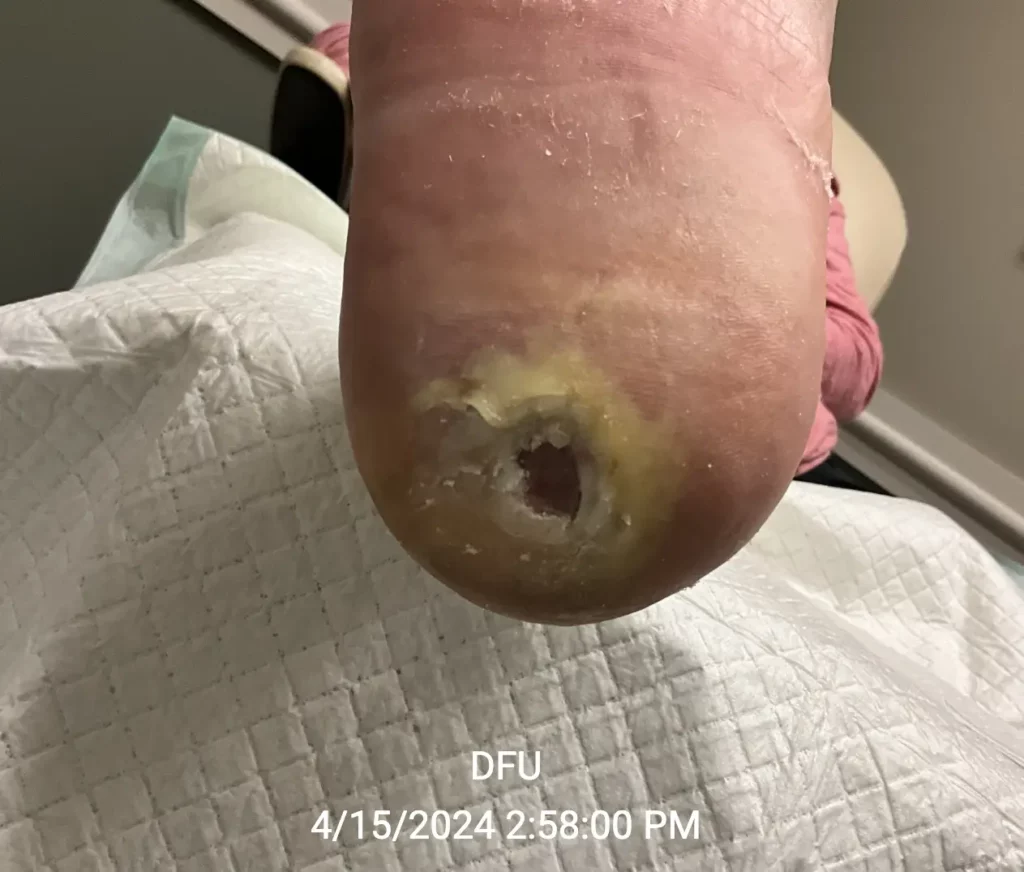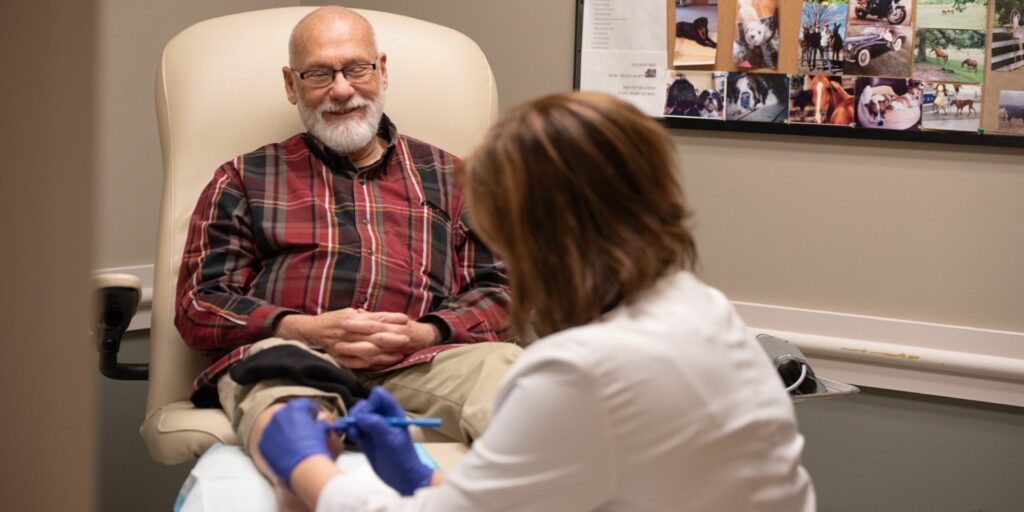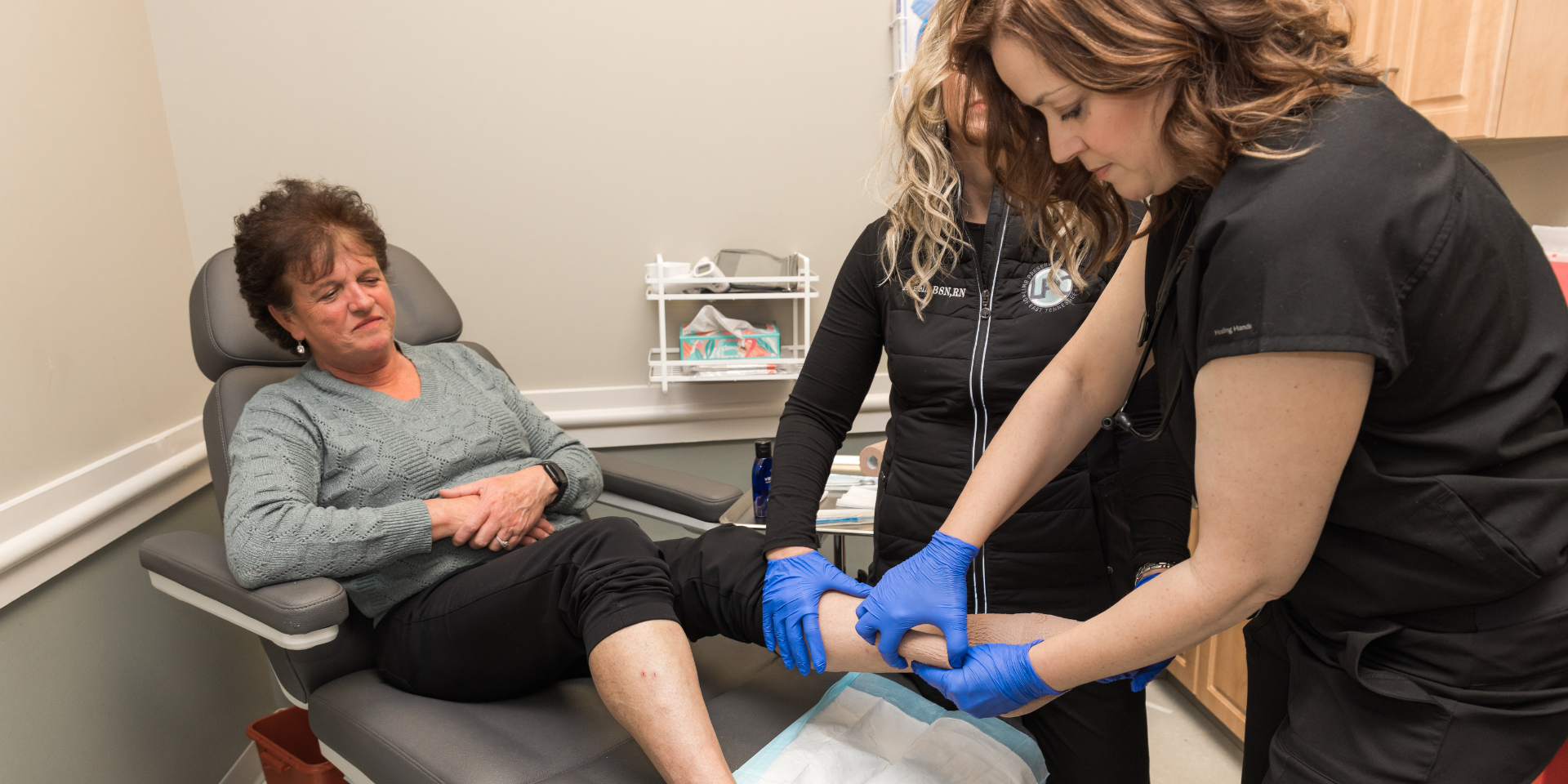Diabetic foot ulcers are a common complication of diabetes mellitus, particularly in those with poorly controlled blood sugar levels. These ulcers typically form on the bottom of the foot and can lead to serious infections, or even amputation, if not treated properly. In fact, diabetes is the leading cause of non-traumatic lower extremity amputations in the United States.
At Limb Preservation Center of East Tennessee, we are dedicated to helping patients on the path toward healing from diabetic foot ulcers. Through a combination of advanced wound care techniques, including wound debridement, proper footwear, and hyperbaric oxygen therapy (HBOT), we have successfully helped patients recover from non-healing foot ulcers and preserve their limbs.
What Are Diabetic Foot Ulcers?
Diabetic foot ulcers are open sores or wounds that occur in approximately 15% of patients with diabetes. They are most commonly located on the bottom of the foot. Far from ordinary wounds, diabetic ulcers heal very slowly, or not at all. If left untreated, the open sores often lead to:
- Infection
- Difficulty walking
- Foot or limb amputation
What Are The Causes of Diabetic Foot Ulcers?
Diabetic foot ulcers develop because of several common issues in people with diabetes, including:
- Peripheral Neuropathy
- Poor Circulation
- Uncontrolled High Blood Sugar (Hyperglycemia)
Peripheral Neuropathy
Peripheral neuropathy is a type of nerve damage in the feet caused by prolonged exposure to high blood sugar levels. It can reduce the ability to feel pain, causing minor injuries to go unnoticed and leading to the development of ulcers.
Poor Circulation
Diabetes can cause blood vessels to narrow and harden, a condition known as peripheral artery disease (PAD). Reduced blood flow to the feet means the tissues receive less oxygen and fewer nutrients necessary for healing. This can cause even small wounds to become chronic ulcers, posing significant risks.
Uncontrolled High Blood Sugar (Hyperglycemia)
Chronic high blood sugar levels, or hyperglycemia, can have a detrimental effect on the body’s ability to heal wounds. It impairs the function of white blood cells, which are crucial for fighting infections. Hyperglycemia also reduces collagen production and hinders the formation of new blood vessels, both essential processes in wound healing.
What Is The Best Way to Treat Diabetic Foot Ulcers?
The best way to treat diabetic foot ulcers is through a personalized and comprehensive wound care plan. At Limb Preservation Center of East Tennessee, we treat these ulcers using a combination of:
- Topical products
- Wound debridement
- Hyperbaric oxygen therapy (HBOT)
- Offloading
- Negative pressure therapy
Topical Products
We use antibiotics or other topical gels, creams, or solutions to help prevent infection and stimulate the healing of diabetic ulcers.
Wound Debridement
Wound debridement is the surgical or nonsurgical removal of dead and infected skin. This helps thoroughly clean the wound and provides patients with the best conditions for complete healing.

Hyperbaric Oxygen Therapy (HBOT)
HBOT is an advanced wound care method of applying pure pressurized oxygen to the area. It has a variety of benefits, from strengthening your immune system to stimulating tissue growth, and can be a game changer for chronic wounds like diabetic foot ulcers.
Offloading
Offloading involves relieving pressure from the wound through proper footwear, foot pads or inserts (orthotics), a brace, or other means. We help diabetic ulcer patients find the best offloading devices to support their healing journey.
Total Contact Casting
Total contact casting (TCC) is a crucial component in the healing process of diabetic foot ulcers. These casts help to relieve pressure on the areas of the foot that are most prone to breaking down and developing ulcers. Due to their effectiveness, we apply a total contact cast to every diabetic foot ulcer patient whenever possible, and it takes just a few minutes to put on.
Patients receive a new cast each week, allowing us to assess the wound and leg, perform any necessary debridement procedures, change the wound dressing, and monitor the healing process. Unfortunately, many wound care centers skip this important step, so it’s important to be aware of TCC benefits when choosing a provider for your diabetic foot ulcer.
Negative Pressure Therapy
Negative pressure therapy uses controlled suction to remove excess fluid from the ulcer. This also helps improve circulation, facilitate the growth of new tissue, and provide a sustainable healing environment.
The earlier that you seek care for your diabetic ulcer, the better chances you have for complete healing. We tailor your wound care based on your individual needs, so the first step is to request an appointment for a chronic wound evaluation. Our board-certified physician, Dr. Heather Hutchings, has specialized in wound care and limb preservation for 13+ years and has successfully treated all stages of diabetic foot ulcers.
Diabetic Foot Ulcer Treatment – Patient Story
*Warning: the following patient story includes photos of a diabetic foot ulcer during various stages of treatment. These images may be considered graphic and disturbing to some readers. Viewer discretion is advised.
It is always encouraging to see the progress that our patients can make when they are dedicated to their healing journeys. We’re excited to share progress photos and updates from a diabetic foot ulcer patient who has made remarkable progress over the past seven months.
In October of 2023, a patient walked into the Limb Preservation Center of East Tennessee with a severe diabetic foot ulcer on her right heel. It was a stark manifestation of her Type 2 diabetes mellitus, an ulcer so deep that the fat layer was exposed. This initial visit marked the beginning of her journey towards healing.
By November 21, 2023, the situation had deteriorated. The ulcer had worsened, primarily due to improper offloading and unsuitable footwear. Our medical team decided to introduce this patient to hyperbaric oxygen therapy (HBOT) starting on March 26, 2024, in hopes of promoting faster and more effective healing.


The day after initiating HBOT, on March 27, 2024, the patient’s condition was beginning to show signs of improvement. The combination of HBOT and weekly wound debridement appeared to be working. However, the generic offloading shoe she had been using wasn’t providing the necessary support. Recognizing this, an appointment was scheduled with an orthotist to get her a customized boot.
By April 15, 2024 progress was still slow, albeit steady. To accelerate the healing process, a skin substitute was applied to the ulcer. This decision proved to be pivotal.


Just ten days later, on April 25, 2024, the patient experienced significantly faster healing. The continued use of HBOT, combined with the application of a second skin substitute, worked wonders.
The real breakthrough came on May 20, 2024. The patient’s condition had greatly improved, thanks to proper footwear, consistent HBOT, and the effective use of skin substitutes. The patient will continue with HBOT and regular checkups to avoid future complications.


This patient’s healing journey is a testament to the power of persistence, proper medical care, and innovative treatments. We not only preserved her limb, but we also were able to restore her hope of a full recovery.
Are you or a loved one living with a stubborn diabetic foot ulcer? Take the first step toward healing by calling our office or requesting an appointment online today!

Diabetic foot ulcers are chronic, non-healing wounds that can lead to serious complications and even limb amputation. However, by seeking treatment early from an advanced wound care specialist, patients can find hope and healing. The best way to treat diabetic foot ulcers is through a combination of techniques, including topical products, wound debridement, hyperbaric oxygen therapy (HBOT), offloading, and negative pressure therapy.
Limb Preservation Center of East Tennessee is the newest and most advanced wound care practice in Lenoir City, Tennessee. Are you looking for experienced wound care that’s convenient and near home? Call Limb Preservation Center of East Tennessee at 865-770-5462 or request an appointment online to arrange a comprehensive chronic wound evaluation with our wound healing experts.






